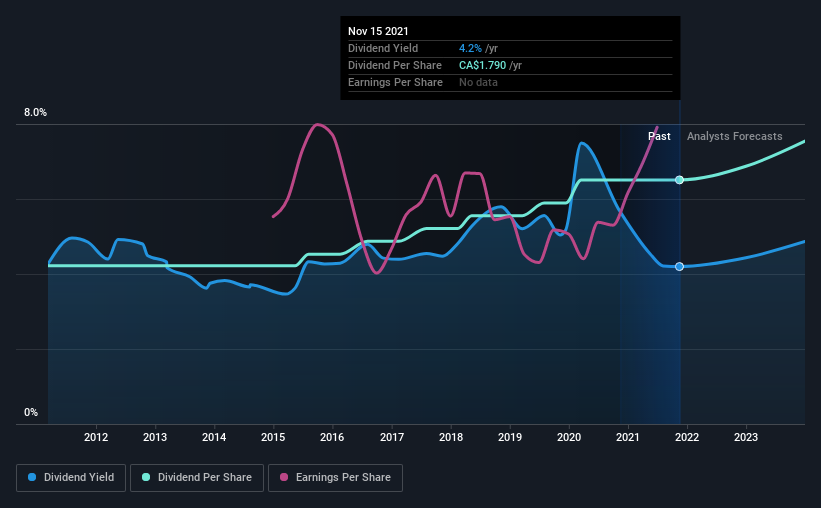Power Corporation of Canada (TSE:POW) Will Pay A Dividend Of CA$0.45
Power Corporation of Canada ( TSE:POW ) has announced that it will pay a dividend of CA$0.45 per share on the 1st of February. Based on this payment, the dividend yield will be 4.2%, which is fairly typical for the industry.
Check out our latest analysis for Power Corporation of Canada
Power Corporation of Canada's Dividend Is Well Covered By Earnings
Solid dividend yields are great, but they only really help us if the payment is sustainable. Based on the last payment, Power Corporation of Canada was quite comfortably earning enough to cover the dividend. This indicates that quite a large proportion of earnings is being invested back into the business.
The next year is set to see EPS grow by 4.3%. Assuming the dividend continues along recent trends, we think the payout ratio could be 43% by next year, which is in a pretty sustainable range.
Power Corporation of Canada Has A Solid Track Record
The company has an extended history of paying stable dividends. The dividend has gone from CA$1.16 in 2011 to the most recent annual payment of CA$1.79. This implies that the company grew its distributions at a yearly rate of about 4.4% over that duration. Although we can't deny that the dividend has been remarkably stable in the past, the growth has been pretty muted.
The Dividend Looks Likely To Grow
Some investors will be chomping at the bit to buy some of the company's stock based on its dividend history. We are encouraged to see that Power Corporation of Canada has grown earnings per share at 16% per year over the past five years. Earnings are on the uptrend, and it is only paying a small portion of those earnings to shareholders.
Power Corporation of Canada Looks Like A Great Dividend Stock
In summary, it is good to see that the dividend is staying consistent, and we don't think there is any reason to suspect this might change over the medium term. Distributions are quite easily covered by earnings, which are also being converted to cash flows. All of these factors considered, we think this has solid potential as a dividend stock.
It's important to note that companies having a consistent dividend policy will generate greater investor confidence than those having an erratic one. Still, investors need to consider a host of other factors, apart from dividend payments, when analysing a company. For example, we've identified 2 warning signs for Power Corporation of Canada (1 makes us a bit uncomfortable!) that you should be aware of before investing. We have also put together a list of global stocks with a solid dividend.
This article by Simply Wall St is general in nature. We provide commentary based on historical data and analyst forecasts only using an unbiased methodology and our articles are not intended to be financial advice. It does not constitute a recommendation to buy or sell any stock, and does not take account of your objectives, or your financial situation. We aim to bring you long-term focused analysis driven by fundamental data. Note that our analysis may not factor in the latest price-sensitive company announcements or qualitative material. Simply Wall St has no position in any stocks mentioned.
Have feedback on this article? Concerned about the content? Get in touch with us directly. Alternatively, email editorial-team (at) simplywallst.com.

 Yahoo Finance
Yahoo Finance 
